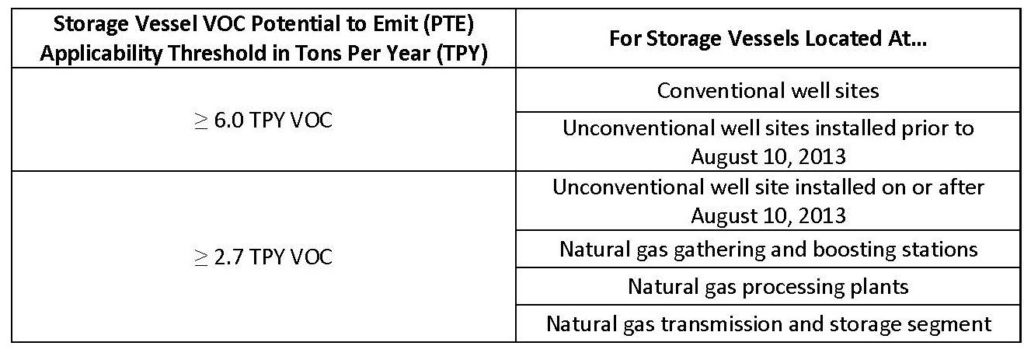What O&G Facility Owners and Operators Need to Know about the Proposed PA CTG RACT Rule
Posted: June 15th, 2020
Authors: Katie F.
On Saturday, May 23, 2020, the Pennsylvania Department of Environmental Protection (PADEP) posted a proposed Reasonably Available Control Technology (RACT) rule in the Pennsylvania Bulletin for the control of volatile organic compound (VOC) emissions from “existing” oil and natural gas sources, commonly referred to as the control techniques guidelines (CTG) RACT Rule. Comments on the proposed CTG RACT Rule are due to PADEP by July 27, 2020. The proposed CTG RACT Rule establishes the VOC emissions limitations and other requirements of the U.S. Environmental Protection Agency (U.S. EPA) recommendations in the Control Techniques Guidelines for the Oil and Natural Gas Industry (2016 O&G CTG). The level of VOC control expressed in the CTG RACT Rule is comparable to the requirements of 40 CFR Part 60 Subpart OOOOa. U.S. EPA has proposed to withdraw the 2016 O&G CTG. If the 2016 O&G CTG is not withdrawn, states with ozone nonattainment areas (and subject to RACT requirements) must revise their State Implementation Plans (SIPs) for the 2008 and later ozone standards to include RACT standards for existing oil and natural gas sources covered by the 2016 O&G CTG no later than January 21, 2021. It is important to note that PADEP does not plan to abandon the CTG RACT Rule even if the 2016 O&G CTG is withdrawn by U.S. EPA. We expect that PADEP will still work to establish the emissions standards by the January 21, 2021 deadline regardless.
The CTG RACT rule is proposed as 25 Pa Code §§129.121 – 129.130 and will regulate VOC emissions that are associated with existing oil and gas operations in Pennsylvania. The rule defines existing as oil and natural gas sources that are in existence on or before the effective date of the proposed rulemaking when published as a final-form rulemaking. PADEP estimates that the rule will apply to over 89,000 unconventional and conventional oil and natural gas wells (of which over 8,400 unconventional and over 71,000 conventional wells are currently in production), approximately 435 midstream compressor stations, 120 transmission compressor stations, and 10 natural gas processing facilities. The sources affected by the proposed CTG RACT Rule are:
- Storage vessels
- Natural gas-driven pneumatic controllers
- Natural gas-driven diaphragm pumps
- Reciprocating and centrifugal compressors
- Fugitive emissions components
In two cases, PADEP determined that more stringent RACT requirements than the 2016 O&G CTG are necessary:
- PADEP proposes a lower VOC applicability threshold is for storage vessels at unconventional well sites installed on or after August 10, 2013 to prevent backsliding, which will also represent RACT for storage vessels at gathering and boosting stations, processing plants, and transmission stations.
- PADEP proposes that owners and operators conduct monthly audio, visual, and olfactory (AVO) inspections and quarterly leak detection and repair (LDAR) inspections of fugitive emissions components at their facilities vs. semiannually for fugitive emissions components at well sites and quarterly for fugitive emissions components at gathering and boosting stations as recommended in the 2016 O&G CTG.
PADEP states that only a limited number of conventional well sites will be subject to LDAR monitoring based on the proposed 15 barrels of oil equivalent per day production threshold, but that other requirements will require conventional operators to assess applicability and take action to comply, as applicable (e.g., storage vessel provisions).
A summary of the proposed CTG RACT Rule as it applies to the affected sources is provided below.
Storage Vessels:
The proposed CTG RACT Rule requirements will apply to storage vessels that meet the following applicability thresholds:
The PTE is to be determined using a generally accepted model or calculation methodology, based on maximum average daily throughput. Owners or operators of storage vessels exceeding the PTE thresholds described above must reduce VOC emissions by 95.0% by weight or greater by either (1) routing the VOC emissions to a control device or process through a closed vent system, or (2) equipping the storage vessel with a floating roof that meets the requirements of 40 CFR Part 60, Subpart Kb. There are certain exceptions and categorical exemptions to the storage vessel requirements proposed at 25 Pa. Code §§129.123(c) and (d).
Natural Gas-Driven Pneumatic Controllers:
The CTG RACT Rule requirements will apply to natural gas-driven pneumatic controllers located prior to the point of custody transfer of oil to an oil pipeline or of natural gas to the natural gas transmission and storage segment. Owners or operators must tag all affected natural gas-driven pneumatic controllers with the compliance date and an identification number and also must ensure that the natural gas bleed rate of the controller meets the following standards:
- ≤0 standard cubic feet per hour (SCFH) if located either (1) between a well head and a natural gas processing plant or (2) between a well head and a point of custody transfer to an oil pipeline.
- Zero SCFH if located at a natural gas processing plant.
Natural Gas-Driven Diaphragm Pumps:
The CTG RACT Rule requirements will apply to natural gas-driven diaphragm pumps located at a well site or natural gas processing plant. The standard for affected natural gas-driven diaphragm pumps is to reduce VOC emissions by 95.0% by weight or greater by complying with the following:
- At well sites: route the VOC emissions to a control device or process through a closed vent system.
- At natural gas processing plants: maintain a VOC emissions rate of zero SCFH.
There are certain exceptions and exemptions to the pump requirements proposed at 25 Pa. Code §§129.125(c) and (d).
Compressors:
The CTG RACT Rule requirements will apply to reciprocating compressors and to centrifugal compressors using wet seals located between the wellhead and point of custody transfer to the natural gas transmission and storage segment. Compressors at transmission compression stations are not subject to the rule. The proposed standards for affected compressors are as follows:
- Reciprocating compressors: replace the rod packing on or before the reciprocating compressor has operated for 26,000 hours or 36 months. Alternately, the owner/operator may route the VOC emissions to a process by using a reciprocating compressor rod packing emissions collection system that operates under negative pressure and meets the requirements of 25 Pa. Code §129.128(a).
- Centrifugal compressors using wet seals: reduce VOC emissions from each centrifugal compressor wet seal fluid degassing system by 95.0% by weight or greater by equipping the wet seal fluid degassing system with a cover that meets the requirements of 25 Pa. Code §129.128(a) and routing emissions through a closed vent system to a control device or a process.
There are certain exemptions to the compressor requirements proposed at §129.126(d).
Fugitive Emissions Components:
The CTG RACT rule requirements for fugitive emissions components are proposed as follows:
Other requirements related to fugitive emissions components under the CTG RACT Rule include development of a fugitive emissions monitoring plan, procedures for verification and operation of optical gas imaging (OGI) equipment and for U.S. EPA Method 21 gas leak detection equipment, leak repair requirements, and options for decreased or extended LDAR inspection intervals. The frequency of required LDAR inspections may be decreased to semi-annually if less than 2% of fugitive emissions components are found to be leaking for two consecutive quarterly surveys.
Additionally, the CTG RACT Rule includes significant requirements associated with covers, closed vent systems, and air pollution control devices. Administrative requirements include monitoring, recordkeeping, and reporting which includes the preparation, certification, and submittal of an initial compliance report one year after the effective date of the published final rule, and annually thereafter, to PADEP. The preamble to the proposed rule mentions the availability of “case-by-case” RACT analyses if the owner or operator cannot meet the provisions of the proposed rulemaking, but such provisions are not explicit in the rule proposal.
If you have questions about how the Pennsylvania CTG RACT Rule or other air quality regulations may apply to your facility, please reach out to me at kfritz@all4inc.com or 610-933-5246 x116.



